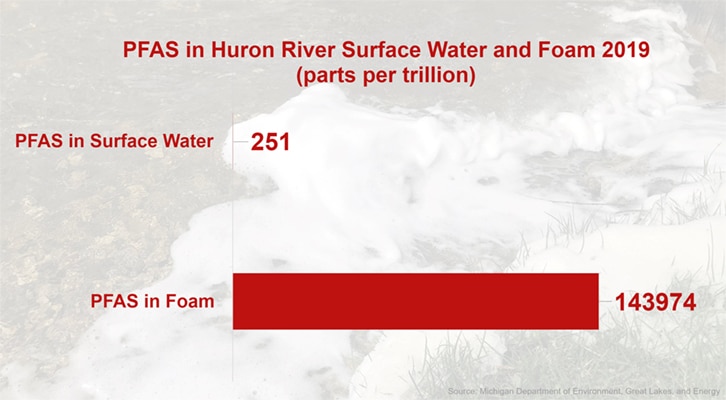
On June 15th, the Environmental Protection Agency (EPA) released new health advisory levels for four PFAS “forever chemicals.” The levels are alarmingly low, confirming what many health experts knew: PFAS are toxic in extremely small doses.
As a part of their assessment, the EPA evaluated the health effects of PFOA and PFOS, two specific PFAS chemicals, and found that regular “lifetime” exposure in drinking water at shockingly low levels compromises the immune system response, increases the risks of various cancers, harms the cardiovascular system, and is linked to decreased birth weight.
These new science-based findings have significant implications for Michigan’s drinking water standards and the Huron River.
The new EPA recommended levels for regular, lifetime exposure in drinking water are:
- PFOA: 4 parts per quadrillion*
- PFOS: 20 parts per quadrillion
- GenX: 10 parts per trillion
- PFBS: 2000 parts per trillion
(* A part per quadrillion is 1/1000th of a part per trillion.)
Note the EPA advisory levels are not enforceable. They’re only recommendations based on the best scientific data available. The EPA has stated that it plans to propose national drinking water regulations for PFOA and PFOS later this year, with a final rule expected in 2023. Political pushback against regulations at the federal level may interfere with that process, however, making updated state protections critical.
The EPA’s recommendations are much stricter than what any state currently has in place. Michigan currently has enforceable drinking water standards (called maximum contaminant levels or MCLs) that were considered reasonably protective compared to other states.
Michigan’s current drinking water standards are:
- PFOA: 8 parts per trillion
- PFOS: 16 parts per trillion
- GenX (HFPO-DA): 370 parts per trillion
- PFBS: 420 parts per trillion
The new EPA recommended maximum levels for PFOS and PFOA are more than 1000 times lower than what Michigan currently has in place. In practical terms, this effectively means there is no safe level of these PFAS chemicals in the environment. The parts per quadrillion levels recommended by the EPA are far below the lowest detectable limit for most tests of 2 parts per trillion, so even if these chemicals are just barely detected, the level would still be way too high.
The Michigan MCL for GenX is now 37 times higher than what the EPA recommends. Curiously, the advisory value for PFBS is more relaxed than Michigan’s standard, and the EPA’s assessment of PFBS generated significant controversy and pushback from experts.
What should we do? We should ban all non-essential PFAS production and use.
There is only one way to keep PFAS below such low levels, and that’s to avoid creating them in the first place. This clearly points to a need to ban all non-essential PFAS production and use. What’s more, PFAS are a class of over 12,000 similar chemicals. The toxicity of a few have been confirmed, but other similar chemicals will almost certainly be similarly toxic. By banning just a few PFAS chemicals, the industry will simply manufacture and spread others to replace the old ones. PFBS, for example, is a replacement chemical for PFOS made by 3M. To keep companies from replacing toxic chemicals with other toxic chemicals, we need to ban or regulate the entire class of PFAS chemicals.
Call your state and federal elected officials to voice your concern. Tell them to ban PFAS as a class for all non-essential uses.
What does this mean for the Huron River?
PFAS are found throughout the Huron River watershed and throughout Michigan. A major source of PFAS contamination to the Huron River was drastically reduced after it was identified in 2018. PFOS and PFOA levels are down more than 99% from where they were a few years ago, but they are still too high, especially in light of the new advisory levels from the EPA.
Drinking Water
Ann Arbor draws most of its drinking water from the Huron River and has been effectively treating their drinking water for PFAS. In recent months, PFOS and PFOA have been undetectable in treated Ann Arbor drinking water. There is, however, currently no way to know exactly what the PFOS and PFOA levels are if they are below the detectable limit of 2 parts per trillion.
Don’t Eat the Fish
The Huron River is also currently under advisories for fish consumption. From most of the Huron River, fish should not be consumed. For parts of the Huron River below I-275, the Michigan Department of Health and Human Services (MDHHS) recently relaxed the advisory to eating fish infrequently. Based on this new information from the EPA, HRWC recommends being even more cautious about fish consumption. Refer to the MDHHS Eat Safe Fish Guidelines and take additional precautions.
Avoid Foam

PFAS concentrates in foam. Even when the level of PFAS in non-foamy surface water is below the state criteria, as it is now in most of the Huron River, PFAS can be found in foam at levels thousands of times higher. The MDHHS advises river users to avoid ingesting foam. HRWC recommends avoiding all contact with river foam. Because foam is commonly found below dams and has been found in water spray and droplets, we also recommend people avoid lingering below dams to reduce inhalation of PFAS in small foamy droplets. If you make contact with river foam, rinse off with non-foamy river water and then cleanup at home when you can.
Other Exposures
We are all exposed to PFAS in many ways. PFAS have been used for decades in everything from dental floss to engine lubricants to Teflon pans to construction materials to waterproof clothing. There are a few things we can all do at home to reduce our exposures. Cooking on plain, untreated stainless steel and iron cookware is recommended. Being mindful of PFAS in food packaging is also a good idea. In reality, however, there are too many ways we are exposed to these chemicals for most individuals to keep straight, and quite frankly, that responsibility shouldn’t fall on consumers. We need to limit PFAS production and halt all non-essential uses.
HRWC Will Keep Working to Address PFAS
HRWC will be continuing to work with state and federal officials to press for urgent action and to communicate new information to watershed residents. Many groups throughout Michigan and the country are now working for stronger protections from these forever chemicals. HRWC is lending its support to these efforts to make sure state and federal policies prioritize the health of people and wildlife over the profit margins of polluters.



